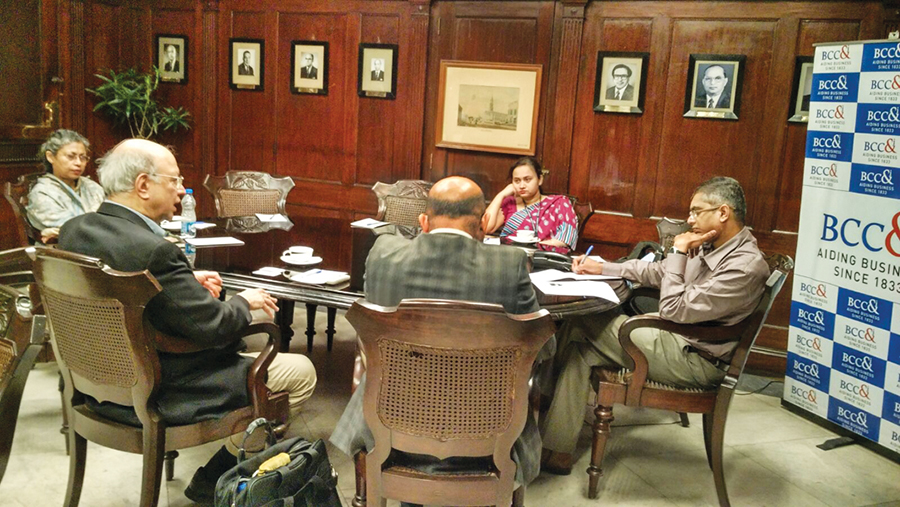- Facilitating Indo-US Science and Technology Forum-Meeting with Professor Ashok Gadgil, Director of the Energy and Environmental Technologies Division at Lawrence Berkeley National Laboratory and Professor of Civil and Environmental Engineering at the University of California, Berkeley and Dr. Sathish Kumar, Senior Manager-R&D, Eureka Forbes Ltd. 14th March 2016, Chamber Premises
The Bengal Chamber of Commerce and Industry, in keeping with its focus of facilitating overseas business linkages especially Indo-US business, organized a meeting between Professor Ashok Gadgil, Director of the Energy and Environmental Technologies Division at Lawrence Berkeley National Laboratory and Professor of Civil and Environmental Engineering at the University of California, Berkeley with Dr. Sathish Kumar, Senior Manager - R&D, Eureka Forbes Ltd on 14th March 2016 in the Chamber.
Mr. Jonathan Ward, Principal Commercial Officer, US Consulate General in Kolkata forwarded this case to the Chamber. It was coordinated by Prof. Joyashree Roy, Coordinator, Global Change Programme, Jadavpur University. Prof. Roy is leading a team which is working to commercialize an arsenic remediation technology developed at the University of California at Berkeley. The commercialization efforts are being made under a grant from the Indo-US Science and Technology Forum. Prof. Gadgil is the developer of the technology and he was himself present in Kolkata on 14th March to meet the potential licensees. Dr. Sathish Kumar came down from Bangalore, on request of the Chamber, exclusively for this meeting.
Prof. Gadgil referred to NITI Aayog which will provide Rs 1,000 crore to save a large population in various States where people are forced to consume groundwater that contains excess of health-crippling arsenic and fluoride. The plan is to install community water purification plants (CWPPs), each of which would provide 1,000 litres of drinking water an hour for which users will have to pay 10 paise per litre. Groundwater contamination - also including that of iron, salinity and nitrate - has become a serious public health crisis, particularly in rural pockets, affecting over 3.61 crore people in 63,831 pockets across half of India's districts, latest government data shows. The said technology also aims to provide arsenic free drinking water to communities. Unlike Reverse Osmosis system, this technology will have no rejection of water. It may be executed completely on local supply chain. Though it requires electricity, intermittent supply may also be utilized. It may also be run on renewable energy. It will, however, be more expensive in that case.
Prof. Roy mentioned that there is huge scope of work for supplying safe irrigation water. Further research may be undertaken for it.
Facilitation of this meeting was in sync with the Chamber’s initiative of setting up a US-India Business Help Desk and Industry-Academia Meet. Apart from Prof. Gadgil, Dr. Kumar and Prof. Joyashree Roy, the meeting was attended by Mr. Arup Kumar Mitra, Senior Commercial Specialist, U.S. Commercial Service and Ms. Angana Guha Roy Chowdhury, Assistant Director, The Bengal Chamber of Commerce and Industry.

 Annual General Meeting 2015
Annual General Meeting 2015 Agro and Rural Development
Agro and Rural Development City of Analytics
City of Analytics Economic Affairs
Economic Affairs Education
Education Entrepreneurship Development
Entrepreneurship Development Energy and Environment
Energy and Environment Exhibitions and Trade Fairs
Exhibitions and Trade Fairs Finance and Banking
Finance and Banking Health
Health HR / IR
HR / IR Information Technology
Information Technology Infrastructure
Infrastructure International Relations
International Relations International Trade Cell
International Trade Cell Leadership Lecture
Leadership Lecture Legal
Legal Metals & Mining
Metals & Mining MSME Development, Manufacturing and Allied Activities
MSME Development, Manufacturing and Allied Activities North Bengal
North Bengal Projects
Projects Shipping
Shipping Skill Development
Skill Development Social and Cultural
Social and Cultural Sports
Sports Taxation
Taxation Think Series
Think Series Tourism and Heritage
Tourism and Heritage Training Programmes and Workshops
Training Programmes and Workshops Other Programmes
Other Programmes Press Clippings
Press Clippings Appendix
Appendix Download
Download


